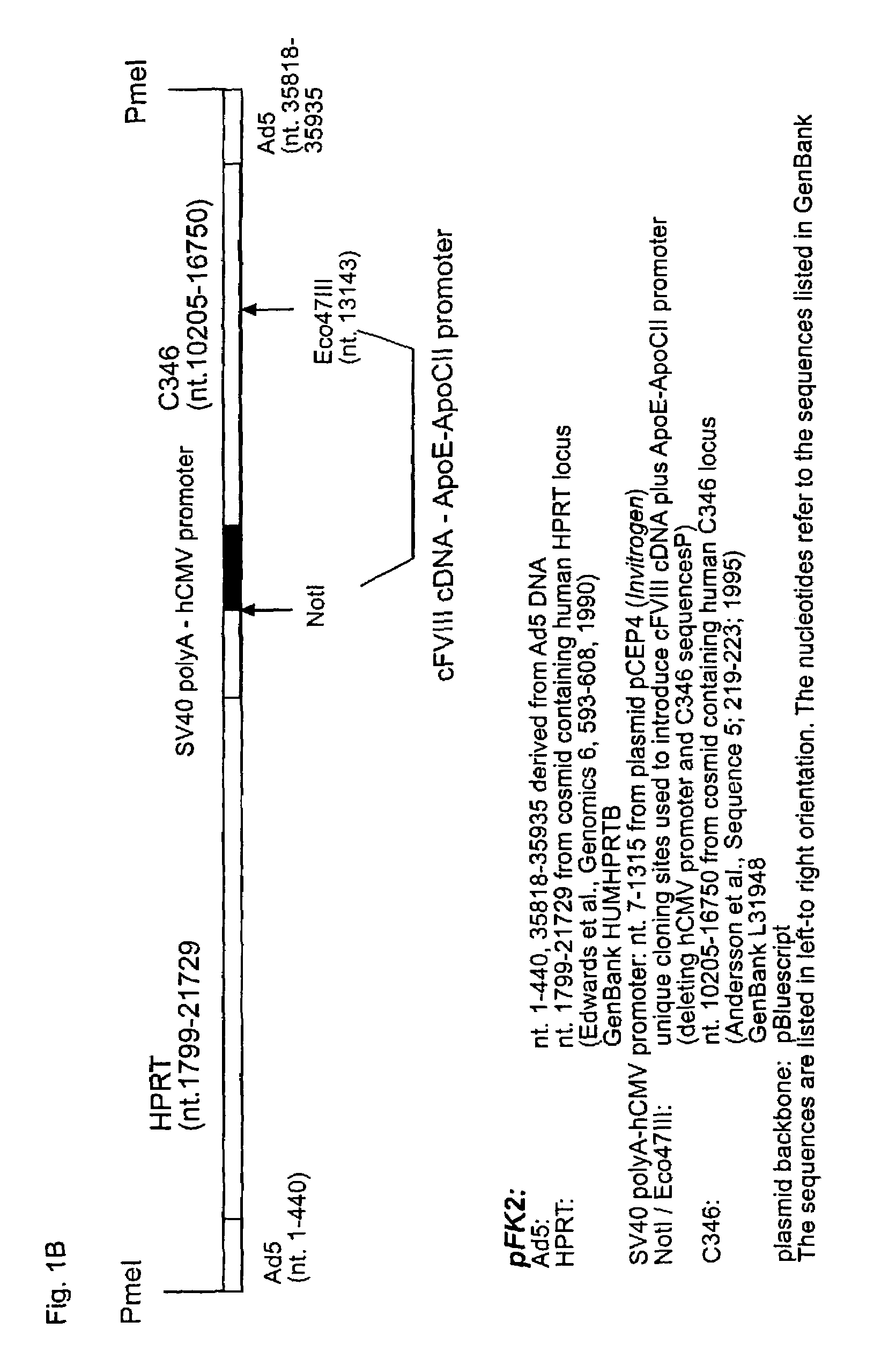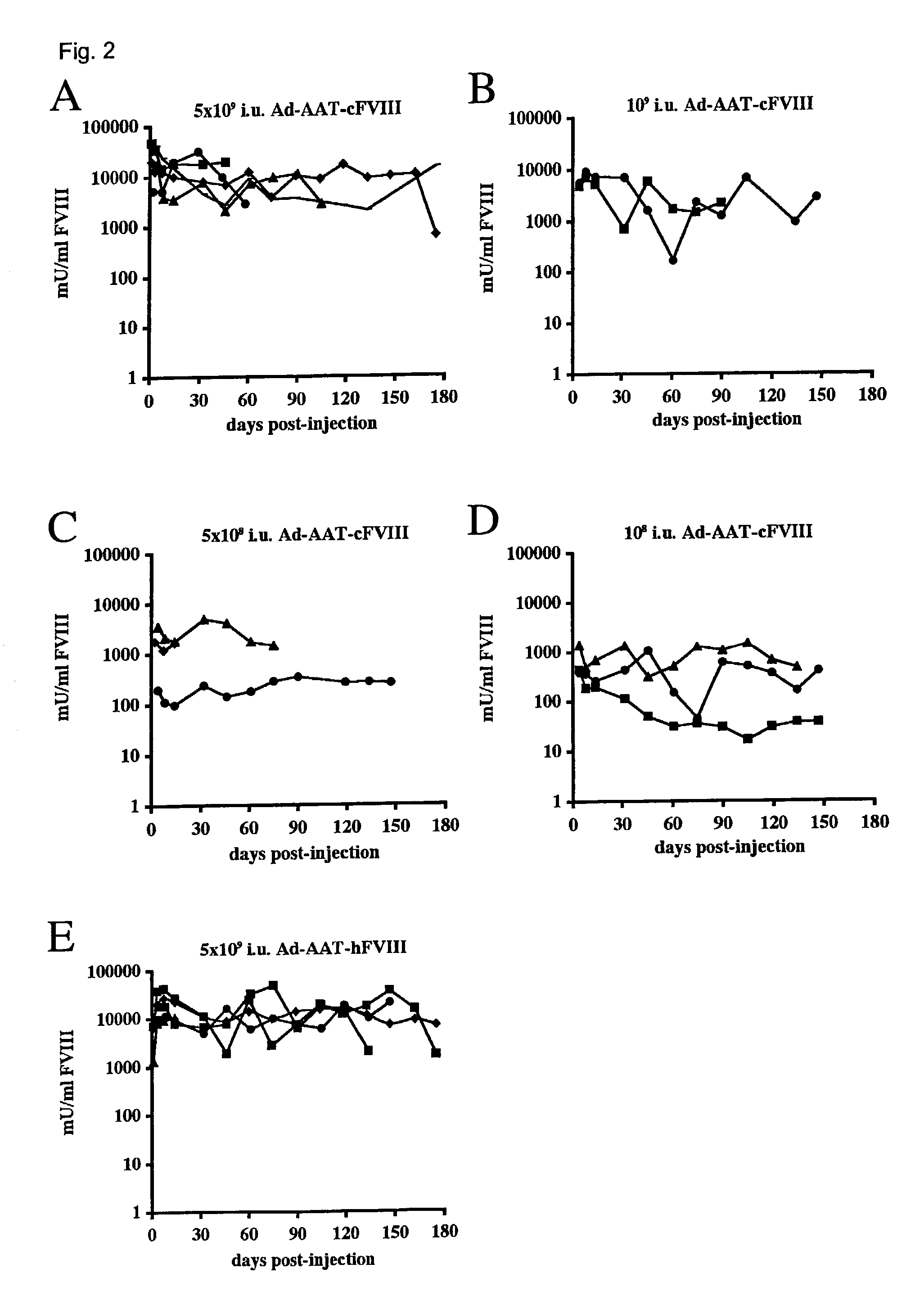High capacity recombinant adenoviral vector for treatment of hemophilia A
a high-capacity, adenoviral technology, applied in the field of adenoviral vectors, can solve the problems of increasing the risk of viral transmission, limited availability, and high cost of purified fviii, and achieve the effect of high human levels and unprecedented bleeding episodes
- Summary
- Abstract
- Description
- Claims
- Application Information
AI Technical Summary
Benefits of technology
Problems solved by technology
Method used
Image
Examples
example 1
[0022]Generation of HC-Ad Vectors
[0023]Three different HC-Ad vectors were compared in the present study (FIG. 1). The Ad-AAT-cFVIII and Ad-AAT-hFVIII vectors express the canine or human B-domain deleted FVIII cDNA, respectively, from the human alfa1-antitrypsin promoter (AAT) (FIGS. 1A& B). An HPRT stuffer fragment was employed to optimize vector size and to avoid vector rearrangements (Parks R J, Graham F L. A helper-dependent system for adenovirus vector production helps define a lower limit for efficient DNA packaging. J Virol. 1997, 71:3293-3298). The rationale for using the AAT promoter was based on previous studies indicating that this promoter can lead to long-term, liver-specific expression of therapeutic proteins following transduction with HC-Ad vectors into immunocompetent mice and baboons (see, Schiedner G, Morral N, Parks R J, Wu Y, Koopmans S C, Langston C, Graham F L, Beaudet A L, Kochanek S. Genomic DNA transfer with a high-capacity adenovirus vector results in impro...
example 2
[0024]HC-Ad Mediated FVIII Gene Delivery in Immunodeficient Hemophilic Mice
[0025]Adult hemophilic FVIIIKO-SCID mice were intravenously injected with the Ad-AAT-cFVIII vector at doses of 5×109, 109, 5×108 and 108 i.u. (FIG. 2A-D). FVIII-deficient littermates were injected with PBS as control. Immunodeficient hemophilic mice were chosen to assess the long-term expression potential of these non-integrating vector type in the absence of confounding immune responses against the human or canine FVIII xenoproteins. The FVIII production in the plasma of recipient mice was determined using a functional FVIII chromogenic assay. The FVIII expression levels were dose dependent with the three highest doses showing supraphysiologic FVIII levels (>1000 mU / ml) (FIG. 2). At the highest vector dose (5×109 i.u.) supraphysiologic canine FVIII levels were achieved for at least 6 months, stabilizing above the 15,000 mU / ml level (FIG. 2A). These levels are at least 15-fold higher than the FVIII concentrat...
example 3
[0028]HC-Ad Mediated FVIII Gene Delivery in Immunocompetent Hemophilic Mice
[0029]To evaluate FVIII expression kinetics in immunocompetent animals, adult hemophilic FVIIIKO mice were intravenously injected with Ad-AAT-cFVIII and Ad-AAT-hFVIII at a dose of 5×109 i.u. (n=6 for each vector). FVIII peak expression levels were observed within 5 to 8 days post-injection (FIGS. 3A & 3B). These peak levels corresponded to 50,000 mU / ml for Ad-AAT-cFVIII and 75,000 mU / ml for Ad-AAT-hFVIII. FVIII levels had fallen to baseline 3-4 weeks post-injection. This decrease in FVIII expression coincided with the induction of high-titer neutralizing antibodies (clinically referred to as “inhibitors”) directed against the xenogeneic FVIII protein (55±45 Bethesda Units / ml).
PUM
| Property | Measurement | Unit |
|---|---|---|
| time | aaaaa | aaaaa |
| clotting time | aaaaa | aaaaa |
| clotting time | aaaaa | aaaaa |
Abstract
Description
Claims
Application Information
 Login to View More
Login to View More - R&D
- Intellectual Property
- Life Sciences
- Materials
- Tech Scout
- Unparalleled Data Quality
- Higher Quality Content
- 60% Fewer Hallucinations
Browse by: Latest US Patents, China's latest patents, Technical Efficacy Thesaurus, Application Domain, Technology Topic, Popular Technical Reports.
© 2025 PatSnap. All rights reserved.Legal|Privacy policy|Modern Slavery Act Transparency Statement|Sitemap|About US| Contact US: help@patsnap.com



